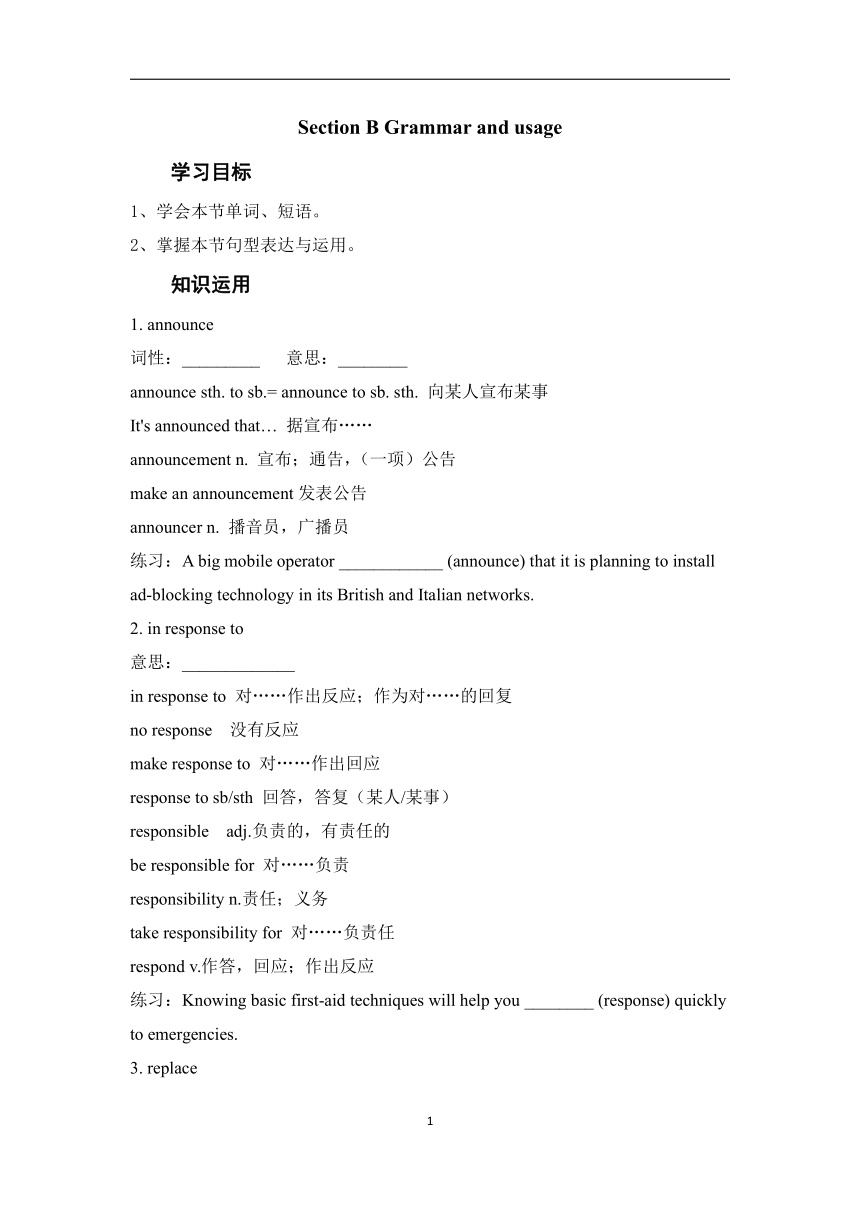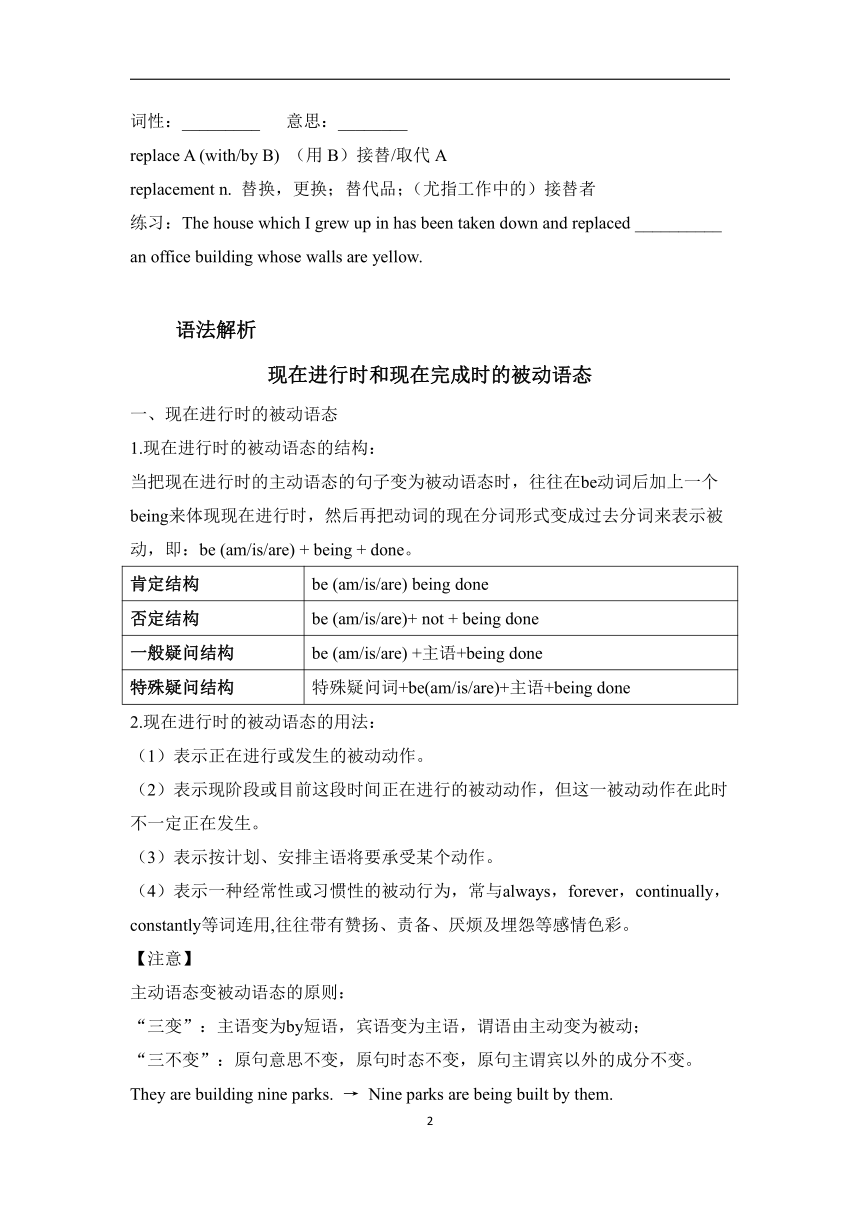牛津译林版(2019)必修第二册Unit 2 Be sporty, be healthy Section B Grammar and usage学案(有答案)
文档属性
| 名称 | 牛津译林版(2019)必修第二册Unit 2 Be sporty, be healthy Section B Grammar and usage学案(有答案) |  | |
| 格式 | doc | ||
| 文件大小 | 48.0KB | ||
| 资源类型 | 教案 | ||
| 版本资源 | 牛津译林版(2019) | ||
| 科目 | 英语 | ||
| 更新时间 | 2022-12-01 15:22:10 | ||
图片预览


文档简介
Section B Grammar and usage
学习目标
1、学会本节单词、短语。
2、掌握本节句型表达与运用。
知识运用
1. announce
词性:_________ 意思:________
announce sth. to sb.= announce to sb. sth. 向某人宣布某事
It's announced that… 据宣布……
announcement n. 宣布;通告,(一项)公告
make an announcement发表公告
announcer n. 播音员,广播员
练习:A big mobile operator ____________ (announce) that it is planning to install ad-blocking technology in its British and Italian networks.
2. in response to
意思:_____________
in response to 对……作出反应;作为对……的回复
no response 没有反应
make response to 对……作出回应
response to sb/sth 回答,答复(某人/某事)
responsible adj.负责的,有责任的
be responsible for 对……负责
responsibility n.责任;义务
take responsibility for 对……负责任
respond v.作答,回应;作出反应
练习:Knowing basic first-aid techniques will help you ________ (response) quickly to emergencies.
3. replace
词性:_________ 意思:________
replace A (with/by B) (用B)接替/取代A
replacement n. 替换,更换;替代品;(尤指工作中的)接替者
练习:The house which I grew up in has been taken down and replaced __________ an office building whose walls are yellow.
语法解析
现在进行时和现在完成时的被动语态
一、现在进行时的被动语态
1.现在进行时的被动语态的结构:
当把现在进行时的主动语态的句子变为被动语态时,往往在be动词后加上一个being来体现现在进行时,然后再把动词的现在分词形式变成过去分词来表示被动,即:be (am/is/are) + being + done。
肯定结构 be (am/is/are) being done
否定结构 be (am/is/are)+ not + being done
一般疑问结构 be (am/is/are) +主语+being done
特殊疑问结构 特殊疑问词+be(am/is/are)+主语+being done
2.现在进行时的被动语态的用法:
(1)表示正在进行或发生的被动动作。
(2)表示现阶段或目前这段时间正在进行的被动动作,但这一被动动作在此时不一定正在发生。
(3)表示按计划、安排主语将要承受某个动作。
(4)表示一种经常性或习惯性的被动行为,常与always,forever,continually,constantly等词连用,往往带有赞扬、责备、厌烦及埋怨等感彩。
【注意】
主动语态变被动语态的原则:
“三变”:主语变为by短语,宾语变为主语,谓语由主动变为被动;
“三不变”:原句意思不变,原句时态不变,原句主谓宾以外的成分不变。
They are building nine parks. → Nine parks are being built by them.
二、现在完成时的被动语态
1.现在完成时的被动语态的构成:
现在完成时的被动语态的结构为has/have been done,使用has been done时主语为单数,使用have been done时主语为复数。
2.现在完成时的被动语态的含义:
现在完成时的被动语态强调一个发生在过去的被动动作,它有两层意思:
(1)动作已完成,强调对现在造成的影响或结果。
(2)主语和谓语动词之间为被动关系。
3.现在完成时的被动语态的用法:
(1)用于不知道动作的执行者是谁时。
(2)用于动作的执行者是泛指或不言自明时。
(3)用于可以说出动作的执行者,但动作的承受者是谈话中心或特别需要强调时。
(4)用于动作的执行者不是人时。
(5)用于出于礼貌、委婉而避免提及自己或对方时。
4.现在完成时的被动语态的各种句式:
肯定式 主语+have/has been done
否定式 主语+have/has not been done
一般疑问式 Have/Has+主语+been done
特殊疑问式 疑问词+have/has+主语+been done
5.现在完成时的主动语态变被动语态:
(1)只带有一个宾语的动词变为被动语态时,将主动语态的宾语变为被动语态的主语。
We have built many houses in the past ten years.(主动)
→Many houses have been built in the past ten years.(被动)
(2)带有双宾语的动词,如give,send,bring,take,teach,show,tell,make,sing,write,read,sell,buy,pay,lend,pass,promise等,变为被动语态时,可将其中一个宾语变为主语,另一个保留不动。
We have given him a book.(主动)
→He has been given a book.(被动)
→A book has been given to him.(被动)
(3)带有复合宾语的动词变为被动语态时,只能将宾语变为主语,原来的宾语补足语成为主语补足语。原来省略to的不定式作宾语补足语的,被动语态中要用带to的不定式。
I found him lying on the floor.(主动)
→He was found lying on the floor.(被动)
练习:1. —Is there anyone in the next room
—Yes, a new applicant ______________ (interview)there.
2. —What preparations have you made for the party
—Invitation cards ___________ (send) to our friends and a big cake __________ (order).
3. —Why so slow
—The road ahead __________ (widen) and only one lane is available.
4. —Can I use your bike
—Sorry, I had a flat tyre five minutes ago and it __________ (repair) now.
5. —Are you still working on your project
—No. Actually, it _____________ (complete).
6. —Having a haircut is really boring.
—I usually read a magazine while my hair __________ (cut).
7. These research base hopes the panda will serve as an __________ (inspire) to patients, giving them hope and strength.
8. Now, most of the traditional architecture is slowly being _________ (replace) by a new style—with cement and modern design.
9. Overhearing the conversation between the girl and her grandmother, the bus driver offered help without any __________ (hesitate).
10. The outstanding traditional Chinese culture is ingrained in the genes of the Chinese people, and ___________ (root) in everyone's heart.
答案
知识运用
1. announces 2. respond 3. with/by
语法解析
1. is being interviewed 2. have been sent; has been ordered 3. is being widened
4. is being repaired 5. has been completed 6.is being cut 7. inspiration 8.replaced
9. hesitation 10. rooted
2
学习目标
1、学会本节单词、短语。
2、掌握本节句型表达与运用。
知识运用
1. announce
词性:_________ 意思:________
announce sth. to sb.= announce to sb. sth. 向某人宣布某事
It's announced that… 据宣布……
announcement n. 宣布;通告,(一项)公告
make an announcement发表公告
announcer n. 播音员,广播员
练习:A big mobile operator ____________ (announce) that it is planning to install ad-blocking technology in its British and Italian networks.
2. in response to
意思:_____________
in response to 对……作出反应;作为对……的回复
no response 没有反应
make response to 对……作出回应
response to sb/sth 回答,答复(某人/某事)
responsible adj.负责的,有责任的
be responsible for 对……负责
responsibility n.责任;义务
take responsibility for 对……负责任
respond v.作答,回应;作出反应
练习:Knowing basic first-aid techniques will help you ________ (response) quickly to emergencies.
3. replace
词性:_________ 意思:________
replace A (with/by B) (用B)接替/取代A
replacement n. 替换,更换;替代品;(尤指工作中的)接替者
练习:The house which I grew up in has been taken down and replaced __________ an office building whose walls are yellow.
语法解析
现在进行时和现在完成时的被动语态
一、现在进行时的被动语态
1.现在进行时的被动语态的结构:
当把现在进行时的主动语态的句子变为被动语态时,往往在be动词后加上一个being来体现现在进行时,然后再把动词的现在分词形式变成过去分词来表示被动,即:be (am/is/are) + being + done。
肯定结构 be (am/is/are) being done
否定结构 be (am/is/are)+ not + being done
一般疑问结构 be (am/is/are) +主语+being done
特殊疑问结构 特殊疑问词+be(am/is/are)+主语+being done
2.现在进行时的被动语态的用法:
(1)表示正在进行或发生的被动动作。
(2)表示现阶段或目前这段时间正在进行的被动动作,但这一被动动作在此时不一定正在发生。
(3)表示按计划、安排主语将要承受某个动作。
(4)表示一种经常性或习惯性的被动行为,常与always,forever,continually,constantly等词连用,往往带有赞扬、责备、厌烦及埋怨等感彩。
【注意】
主动语态变被动语态的原则:
“三变”:主语变为by短语,宾语变为主语,谓语由主动变为被动;
“三不变”:原句意思不变,原句时态不变,原句主谓宾以外的成分不变。
They are building nine parks. → Nine parks are being built by them.
二、现在完成时的被动语态
1.现在完成时的被动语态的构成:
现在完成时的被动语态的结构为has/have been done,使用has been done时主语为单数,使用have been done时主语为复数。
2.现在完成时的被动语态的含义:
现在完成时的被动语态强调一个发生在过去的被动动作,它有两层意思:
(1)动作已完成,强调对现在造成的影响或结果。
(2)主语和谓语动词之间为被动关系。
3.现在完成时的被动语态的用法:
(1)用于不知道动作的执行者是谁时。
(2)用于动作的执行者是泛指或不言自明时。
(3)用于可以说出动作的执行者,但动作的承受者是谈话中心或特别需要强调时。
(4)用于动作的执行者不是人时。
(5)用于出于礼貌、委婉而避免提及自己或对方时。
4.现在完成时的被动语态的各种句式:
肯定式 主语+have/has been done
否定式 主语+have/has not been done
一般疑问式 Have/Has+主语+been done
特殊疑问式 疑问词+have/has+主语+been done
5.现在完成时的主动语态变被动语态:
(1)只带有一个宾语的动词变为被动语态时,将主动语态的宾语变为被动语态的主语。
We have built many houses in the past ten years.(主动)
→Many houses have been built in the past ten years.(被动)
(2)带有双宾语的动词,如give,send,bring,take,teach,show,tell,make,sing,write,read,sell,buy,pay,lend,pass,promise等,变为被动语态时,可将其中一个宾语变为主语,另一个保留不动。
We have given him a book.(主动)
→He has been given a book.(被动)
→A book has been given to him.(被动)
(3)带有复合宾语的动词变为被动语态时,只能将宾语变为主语,原来的宾语补足语成为主语补足语。原来省略to的不定式作宾语补足语的,被动语态中要用带to的不定式。
I found him lying on the floor.(主动)
→He was found lying on the floor.(被动)
练习:1. —Is there anyone in the next room
—Yes, a new applicant ______________ (interview)there.
2. —What preparations have you made for the party
—Invitation cards ___________ (send) to our friends and a big cake __________ (order).
3. —Why so slow
—The road ahead __________ (widen) and only one lane is available.
4. —Can I use your bike
—Sorry, I had a flat tyre five minutes ago and it __________ (repair) now.
5. —Are you still working on your project
—No. Actually, it _____________ (complete).
6. —Having a haircut is really boring.
—I usually read a magazine while my hair __________ (cut).
7. These research base hopes the panda will serve as an __________ (inspire) to patients, giving them hope and strength.
8. Now, most of the traditional architecture is slowly being _________ (replace) by a new style—with cement and modern design.
9. Overhearing the conversation between the girl and her grandmother, the bus driver offered help without any __________ (hesitate).
10. The outstanding traditional Chinese culture is ingrained in the genes of the Chinese people, and ___________ (root) in everyone's heart.
答案
知识运用
1. announces 2. respond 3. with/by
语法解析
1. is being interviewed 2. have been sent; has been ordered 3. is being widened
4. is being repaired 5. has been completed 6.is being cut 7. inspiration 8.replaced
9. hesitation 10. rooted
2
